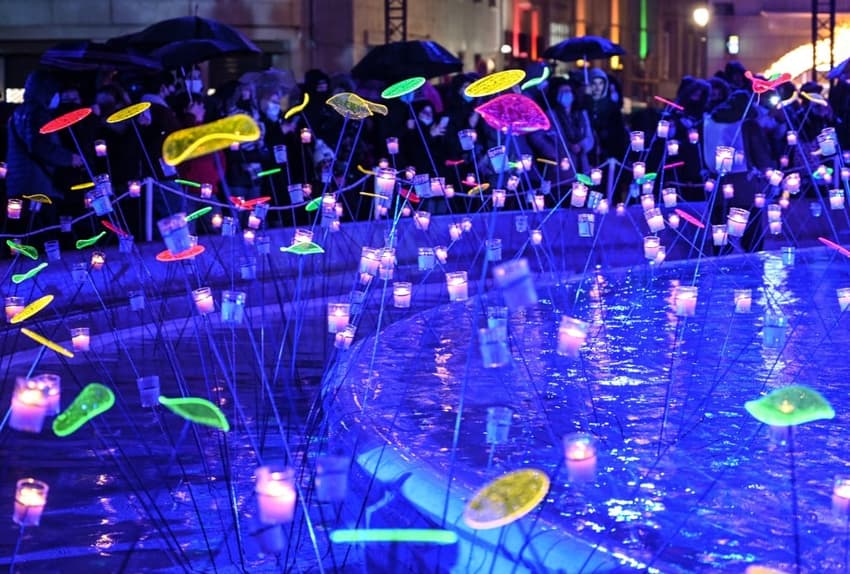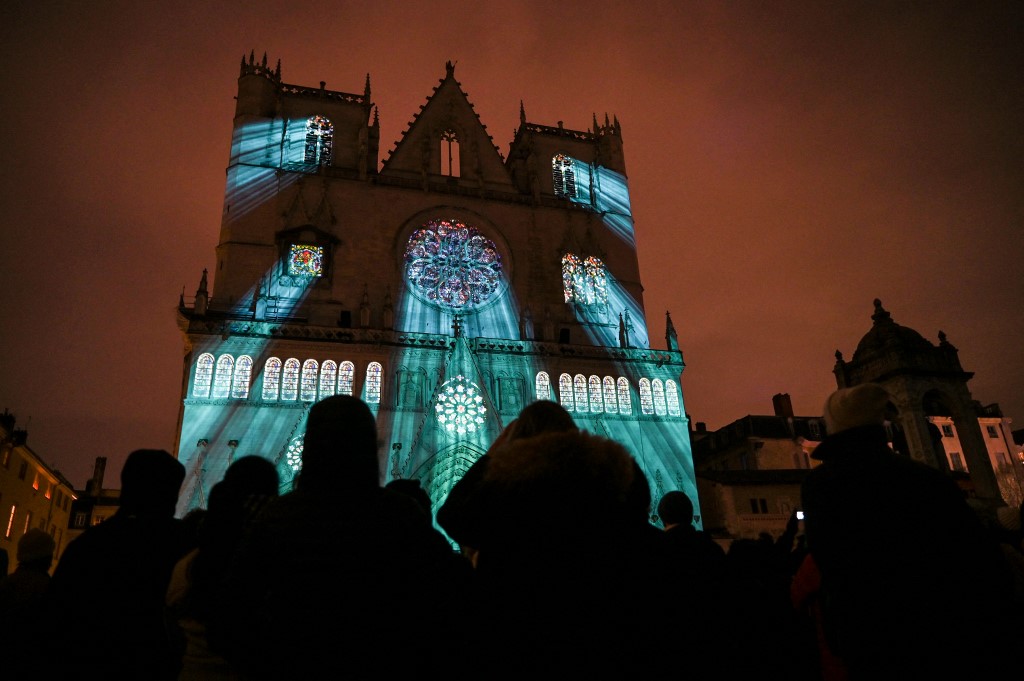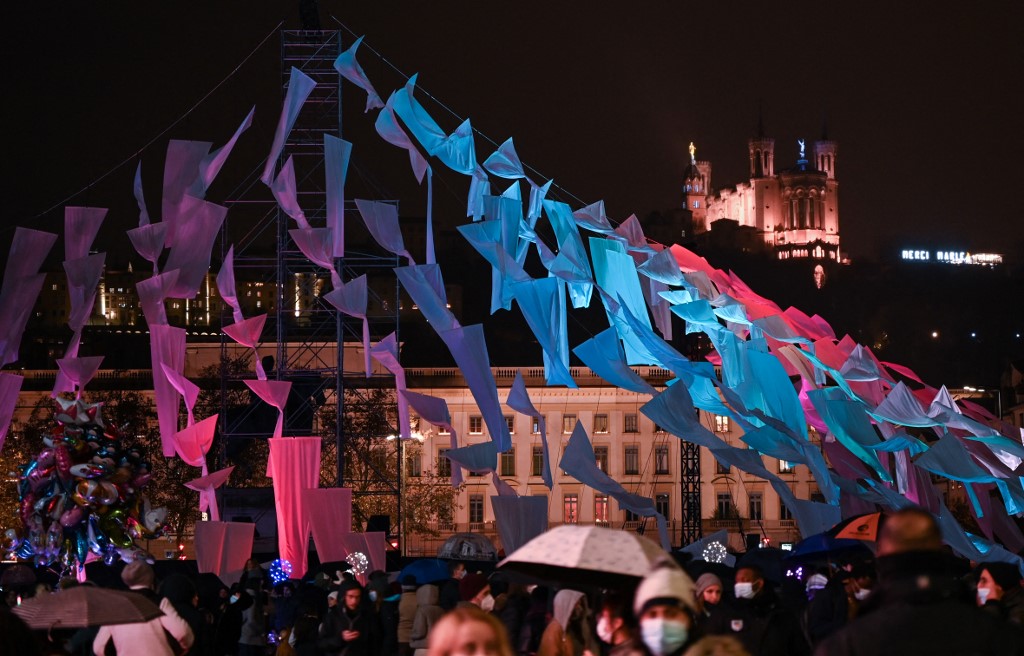Everything you need to know about Lyon's Fête des lumières

Lyon's Fête des lumières is the biggest and most famous of France's winter festivals of lights - Lyon resident and festival fan Caroline Conner explains what it's all about.
What is it?
The Fête des Lumières is a free, outdoor experience in the centre of Lyon that runs from Thursday, December 8th until Sunday, December 11th at night time.
Lyon's annual winter festival of lights always runs for four nights around December 8th.
Every year, different artisans create light installations throughout the city, especially in the centre of Lyon. These include large projections over some of the city’s most beautiful monuments. You'll find incredible exhibitions displayed over the facades of major landmarks like the Hôtel de Ville and Place des Terreaux, at Place Bellecour, and the Cathedral St George. Our famous Parc de la Tête d'Or also has wonderful installations.
While the festival has a wonderful convivial energy, it can also get extremely crowded. Most of the visitors are from the region, but there is starting to be some foreign presence as well.

Saint-Jean cathedral illuminated during the Festival of Lights . Photo by PHILIPPE DESMAZES / AFP
The history of a Lyonnais tradition
Lyon has long been enamoured with the city's patron saint, the Virgin Mary. The worship of Mary goes far back, and in 1643 Lyon officially placed itself under her protection. Ever since, there has been a candle-lit procession between the Cathedral and her chapel on the Fourvière hill (now part of the Basilica) on September 8th.
The first Fête des Lumières was supposed to take place on September 8th 1852 to inaugurate the statue of the Virgin at Fourvière, but the event got rained out. It was rescheduled for December 8th, when it rained once again, yet the Lyonnais people came out with their lanterns lit to show their respect for Mary anyway.
The festival gained momentum throughout the late 1990s and early 2000s, to become an international showcase of fabulous lighting installations.
Today the festival is a free, outdoor, often interactive art festival showcasing at least 40 large scale light installations across the city. In 2021 it was estimated to have had 1,800,000 visitors.
The people of Lyon still pay homage to Mary by lighting candles in their windows on the 8th of December.
How to make the most of the festival
Finding accommodation in Lyon during this time is doable but comes with a cost! Many locals will leave for the weekend and rent out their apartments on Airbnb.
Parking in the centre of town will be very difficult, it's better to reserve a spot in a lot in the 3rd, 4th, 6th, 3rd, 7th, 8th, or 9th arrondissements and take public transport or walk in to the centre.
Restaurants in Lyon tend to be very small, so if you are planning on going, it is crucial that you make reservations. Google reviews function well here and lead to better results than TripAdvisor.
It might rain, just as it did at the very first festival in 1852. Dress appropriately for the weather, which will be cold and likely wet. You will likely be outside in the dark and cold for a few hours, so really bundle up and wear good shoes.

The illuminated Bellecour square, with the Fourviere basilica in the background,. Photo by PHILIPPE DESMAZES / AFP
The festival is free to enjoy but there is a security perimeter around the centre of Lyon. Consult the map to find out which checkpoint you'll enter through, and go early so you can get in without too much of a wait.
The official times for the festival are 8pm until midnight Thursday through Saturday, and 6pm to 10pm on Sunday. To avoid the queues, it would be wise to be inside the perimeter before that start time.
Here is the official map for the Fête des Lumières 2022.
There are no Covid restrictions in place this year.
Find the official website here.
How long does it take?
It would be difficult to see everything in one night if you also wanted to go to the Parc de la Tête d'Or, but you could see most everything in the Presqu'Île (the peninsula between the Rhône and Saône rivers) and even the Old Town in a single evening if you started at 8 and stayed till midnight.
Is there a difference between the nights?
All of the installations are the same for all four nights.
An insider tip is to go and check out the dress rehearsal on Wednesday evening. You won't see everything exactly as it will be, but it's much less crowded and still a fantastic experience.
Friday and Saturday are the most crowded.
Caroline Conner is a wine expert who runs Lyon Wine Tastings. She will be hosting a highly limited gastronomic wine tour on Sunday the 11th that includes a 7 wine tasting, a tour of the Fête des Lumières, and then an extravagant dinner at one of Lyon's best restaurants. Find full details here.
Comments
See Also
What is it?
The Fête des Lumières is a free, outdoor experience in the centre of Lyon that runs from Thursday, December 8th until Sunday, December 11th at night time.
Lyon's annual winter festival of lights always runs for four nights around December 8th.
Every year, different artisans create light installations throughout the city, especially in the centre of Lyon. These include large projections over some of the city’s most beautiful monuments. You'll find incredible exhibitions displayed over the facades of major landmarks like the Hôtel de Ville and Place des Terreaux, at Place Bellecour, and the Cathedral St George. Our famous Parc de la Tête d'Or also has wonderful installations.
While the festival has a wonderful convivial energy, it can also get extremely crowded. Most of the visitors are from the region, but there is starting to be some foreign presence as well.

The history of a Lyonnais tradition
Lyon has long been enamoured with the city's patron saint, the Virgin Mary. The worship of Mary goes far back, and in 1643 Lyon officially placed itself under her protection. Ever since, there has been a candle-lit procession between the Cathedral and her chapel on the Fourvière hill (now part of the Basilica) on September 8th.
The first Fête des Lumières was supposed to take place on September 8th 1852 to inaugurate the statue of the Virgin at Fourvière, but the event got rained out. It was rescheduled for December 8th, when it rained once again, yet the Lyonnais people came out with their lanterns lit to show their respect for Mary anyway.
The festival gained momentum throughout the late 1990s and early 2000s, to become an international showcase of fabulous lighting installations.
Today the festival is a free, outdoor, often interactive art festival showcasing at least 40 large scale light installations across the city. In 2021 it was estimated to have had 1,800,000 visitors.
The people of Lyon still pay homage to Mary by lighting candles in their windows on the 8th of December.
How to make the most of the festival
Finding accommodation in Lyon during this time is doable but comes with a cost! Many locals will leave for the weekend and rent out their apartments on Airbnb.
Parking in the centre of town will be very difficult, it's better to reserve a spot in a lot in the 3rd, 4th, 6th, 3rd, 7th, 8th, or 9th arrondissements and take public transport or walk in to the centre.
Restaurants in Lyon tend to be very small, so if you are planning on going, it is crucial that you make reservations. Google reviews function well here and lead to better results than TripAdvisor.
It might rain, just as it did at the very first festival in 1852. Dress appropriately for the weather, which will be cold and likely wet. You will likely be outside in the dark and cold for a few hours, so really bundle up and wear good shoes.

The festival is free to enjoy but there is a security perimeter around the centre of Lyon. Consult the map to find out which checkpoint you'll enter through, and go early so you can get in without too much of a wait.
The official times for the festival are 8pm until midnight Thursday through Saturday, and 6pm to 10pm on Sunday. To avoid the queues, it would be wise to be inside the perimeter before that start time.
Here is the official map for the Fête des Lumières 2022.
There are no Covid restrictions in place this year.
Find the official website here.
How long does it take?
It would be difficult to see everything in one night if you also wanted to go to the Parc de la Tête d'Or, but you could see most everything in the Presqu'Île (the peninsula between the Rhône and Saône rivers) and even the Old Town in a single evening if you started at 8 and stayed till midnight.
Is there a difference between the nights?
All of the installations are the same for all four nights.
An insider tip is to go and check out the dress rehearsal on Wednesday evening. You won't see everything exactly as it will be, but it's much less crowded and still a fantastic experience.
Friday and Saturday are the most crowded.
Caroline Conner is a wine expert who runs Lyon Wine Tastings. She will be hosting a highly limited gastronomic wine tour on Sunday the 11th that includes a 7 wine tasting, a tour of the Fête des Lumières, and then an extravagant dinner at one of Lyon's best restaurants. Find full details here.
Join the conversation in our comments section below. Share your own views and experience and if you have a question or suggestion for our journalists then email us at [email protected].
Please keep comments civil, constructive and on topic – and make sure to read our terms of use before getting involved.
Please log in here to leave a comment.